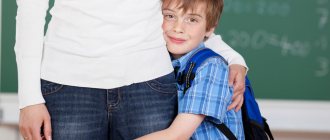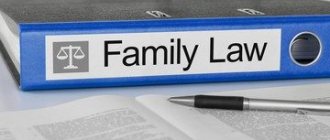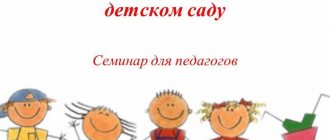MAGAZINE Preschooler.RF
Slide 2 Life begins in childhood, as was believed in ancient times. Children are the most precious thing in any society, regardless of political system and religious belief. Slide 3 It is in preschool childhood that the foundation for the development of a future citizen is laid. Every modern person dreams of living in a civilized legal state, where he is protected and confident in the future. Today's children are the future of our country. What the future of children and the state will be depends on many reasons. One thing is certain: the well-being of Russian citizens is possible only in a rule-of-law state. Slide 4 Very often lately the media have reported on another fact of violation of the rights of a child in the family. The reason for this is not the absence of laws or their insufficiency, but that these laws are either unknown to adults or are ignored by them.Slide 5 Therefore, one of the most important areas of cooperation between kindergarten and parents is the prevention of violations of the rights of the child in the family. Slide 6 Work is carried out in two directions: - work with children - work with parents
Slide 7 In the process of studying this material, the teacher is given the following tasks: - to acquaint each child with his rights guaranteed by the laws of the country in which he lives; — develop respect and tolerance for people, regardless of their social origin, race and nationality; - promote the formation of self-esteem, awareness of one’s rights and freedoms, a sense of responsibility (for another person, for a given word); — introduce parents to legal documents, basic rights and responsibilities of the family itself; — work to prevent child abuse.
Slide 8 The purpose of legal education of preschool children is:
- introducing children to human rights, instilling respect for the rights of another person, developing an emotionally positive attitude towards the most important moral qualities (kindness, mercy, compassion);
- formation of goodwill and sensitivity to others, respectful attitude towards them, attracting the child’s attention to their rights, formation of moral norms and rules of behavior;
— consolidation of acquired knowledge in everyday life and gradual accumulation of experience in observing rights.
Slide 9 To form in preschoolers basic ideas about their rights and freedoms, to develop respect and tolerance for other people and their rights, it is important not only to provide knowledge, but also to create conditions for their practical application. When organizing work in this area, it is necessary to rely on the main types of activities for preschoolers: gaming and artistic-productive.
Slide 10 It is recommended to carry out: - role-playing, theatrical and didactic games (“Family”, “Hospital”, “School”, “Kolobok”, “Zayushkina’s hut”, “I have the right”, “Guide”, “Who violated the rights”) ; — games and exercises for the development of the emotional sphere (“Help yourself”, “Tender names”). Slide 11 Organize: - problem-search activities of children; - productive activities.
Slide 12 Forms of work with preschoolers used: classes, games, conversations, Slide 13 leisure, entertainment, joint activities of the teacher with children outside specially organized classes, Slide 14 Classes are held once a month. Preliminary work and work to consolidate material are included in the daily and independent activities of children. Consolidating children’s ideas about their rights can be reflected in such areas of organized educational activities as “Communication”, “Cognition”, “Artistic Creativity”, “Socialization”, “Labor”, “Music”, “Physical Education”. In addition, children’s ideas can be replenished and consolidated in other forms of organization and types of children’s activities that involve the use of direct observation (excursions, walks), experimental research activities that allow children to independently draw a conclusion, verify something (count the pulse, listen heartbeat). It is very important to give children the opportunity to apply the acquired knowledge in practical activities - creative and educational games, and try to use this knowledge in communicating with other people, in holidays and entertainment.
Slide 15 Due to the fact that parents, in addition to children and teachers, are participants in the educational process, the proposed system of work includes a block of interaction with the family. The main tasks in working with parents: -increase the level of legal culture of parents, their competence in raising a child; - rebuild the initial view of the child, help to understand and accept that the child is an equal person who has the right to his own actions and opinions; -identify families at risk, conduct corrective work with dysfunctional families; - enhance the role of the family as a social institution that determines not only the development of the child as an individual, but also of society as a whole.
Slide 16 Cooperation with the family involves solving the problems of providing assistance to parents through individual and frontal classes, using traditional and non-traditional forms, activating and enriching the educational skills of parents. Slide 17 Individual forms:
- conversations (“Healthy lifestyle”, “Every home has its own traditions”) - consultations (“Children’s aggression”, “Protecting the rights and dignity of the child”, “Safety of preschoolers”) - visiting families Slide 18 The most common in cooperation with families are conversations. Each conversation is individual; it depends on specific people, on specific situations. By communicating with parents individually, the teacher gets the opportunity to establish relationships with them based on mutual respect, outline ways to effectively help the family, and give specific advice to parents. Slide 19 An important link in individual work with parents is visiting the family. It allows the teacher to get acquainted with the conditions in which the child lives and the general atmosphere in the house. As a result, the teacher can give parents more informed recommendations and find optimal ways to create a single line of influence on the child in kindergarten and at home.
Slide 20 Frontal forms:
— traditional parent meetings at which problems of the group’s life are discussed; — question and answer evenings; - holding joint holidays where parents are not passive spectators, but active participants (“Dad, Mom, I am a sports family”, “Mother’s Day”, “Family Day”).
The main form of work with a group of parents is a group parent meeting. The topics of pedagogical conversations are determined taking into account the interests and wishes of parents. A meeting between parents and teachers becomes lively if it is accompanied by a display of children's works and a tour of the kindergarten. Slide 21 Non-traditional forms are built according to the type of entertainment programs aimed at attracting the attention of parents to the kindergarten and establishing informal contacts. Parents can get to know their child better. These forms shorten the emotional distance.
In the work system of teachers, it is important to use all forms of work. The choice depends on the individuality of the teacher and parents, as well as the needs and desires of the parents. Slide 22 As a result of the work, the children’s interest in their peers, their affairs and actions increased; they became more attentive to the mood of other children and adults, more friendly and caring; They began to express their opinions more often and defend their point of view. Parents have become more attentive to their children and are interested in their affairs and the affairs of the group. Dads began to take a more active role in raising their children. The work gives positive results. Slide 23 Thank you for your attention.
| Next > |
Presentation “Children’s Legal Aid Day”
#Educational materials #Presentation #Educator #Psychologist #Speech therapist #Music director #Preschool education
The main documents that contain the rights of the child: The Declaration of the Rights of the Child was adopted by the UN General Assembly (11/20/1959) The Convention on the Rights of the Child was adopted by the UN General Assembly (11/20/1989) in our country came into force on 09/02/1990 Constitution RF (Chapter 2 Rights and freedoms of man and citizen adopted on December 12, 1993) Family Code of the Russian Federation (adopted on November 15, 1997) Federal Law of July 24, 1998 N 124-FZ “On the basic guarantees of the rights of the child in the Russian Federation.”
International documents on children's rights: The Declaration of the Rights of the Child is an official document that states the rights of the child. It declares the basic principles and recommendations. There are ten of them in total. The Universal Declaration of Human Rights states that “the fundamental right of every person is the right to life.” The Convention on the Rights of the Child is an international treaty that sets out the rights of the child. Convention translated from Latin is a treaty, an agreement on a special issue that is binding on those states that have signed it. It contains three parts, 54 articles.
The Constitution of the Russian Federation is the basic Law of our country. Fundamental rights can be classified as: * personal (right to life); * political (right to freedom of speech, conscience); * civil (suffrage); * socio-economic (right to work, rest, education, clean environment); * cultural (the right to one’s national culture, language).
The Constitution of the state also enshrines the basic responsibilities of citizens: * Observe the laws of the state * Pay taxes, fees * Protect the Fatherland * Preserve nature * Take care of children and disabled parents * Preserve cultural monuments
In addition to the Constitution of the Russian Federation, the rights of a child student are also enshrined in other documents: Federal Law “On Education in the Russian Federation” Law “On Basic Guarantees of the Rights of the Child in the Russian Federation” 120 - Federal Law “On the Fundamentals of the System for the Prevention of Neglect and Juvenile Delinquency” Charter of the Preschool Educational Institution
A person's life begins in the family. If peace and harmony reign in the family, a person feels confident and calm. In the Russian Federation, the family is the object of state family policy. The goal of state family policy is to provide the state with the necessary conditions for the family to realize its functions and improve the quality of life. Family relations are regulated in our country by family law. “A child is a person until he reaches the age of 18 years (the age of majority)”, - RF Law of July 24, 1998 No. 124-FZ “On the Basic Guarantees of the Rights of the Child in the Russian Federation”).
* to receive a surname, name, patronymic; * live and be raised in a family; * know your parents, live together with them, as well as care from your parents, education by them and comprehensive development; * to communicate with parents and other relatives (in case of divorce between parents, separation of parents, stay in a medical institution, in case of detention, arrest, detention); * to protect and restore their legal rights and interests; * to express one’s opinion when resolving any issue in the family; * to receive maintenance from their parents and other family members; * own and use the property of parents when living together with them; * for housing and protection of their housing rights from abuse, including by parents (guardians, trustees); * ownership of property received as a gift or by inheritance. A child in a family has the right:
At what age does a child have the right to express his or her own opinion? This age is not limited by law. The child has the right to express his opinion when resolving any issues affecting his interests in the family.
Who and how is obliged to protect the rights and legitimate interests of the child? The protection of the rights and legitimate interests of the child is carried out by parents, adoptive parents, guardians, trustees, guardianship and trusteeship authorities, the prosecutor, and the court. If the rights and legitimate interests of a child are violated by parents, the child has the right to apply to the guardianship and trusteeship authorities, and upon reaching the age of 14, to independently go to court.
Everyone should know and remember that when exercising their own rights, it is unacceptable to violate the rights of other people. “By what measure would you like to be measured, so do you, and as you want to be treated, so do you” - this is how the biblical sages imagined the relationship between rights and responsibilities
All children have equal rights, regardless of race, colour, sex, language, religion, political or other opinion, and regardless of the place of birth and status of their parents. * the right to learn, be educated and develop physically and spiritually, in healthy and normal conditions; * the right to a name and belonging to a country; * the right to protection, good food, housing and medical care; * the right to love and understanding from one’s parents and family, as well as from the state if relatives cannot help; * the right to be protected against acts of cruelty or exploitation, they are not obliged to do work that impedes their development, either physically or mentally
Presentation on the topic: “Me and my rights” presentation for the lesson (preparatory group) on the topic
Slide 1
“Me and my rights” by teacher of preschool educational institution No. 17, Serpukhov-15, Marina Yurievna Melnikova
Slide 2
What is the name of the document that enshrines the rights of the child in our country? Convention on the Rights of the Child
Slide 3
Right to life No one can ever deprive a child of LIFE
Slide 4
What rules of behavior do children break? “A lighter is not a toy!” — Every preschool child remembers. That fire is not your friend, Children should know from the cradle! Hairdryers are very bad jokes! Explain this to the little one. Well, if it’s near the water, you can’t avoid trouble!”
Slide 5
Remember what the fairy tale is called? Think about which heroes’ right to life was violated? Who tried to violate this right? You, of course, remember that this is a Russian folk tale “The Wolf and the Seven Little Goats.” In it, the wolf tried to violate the kids’ right to life.
Slide 6
Every child has the right to a name. Children have different names. Why, why do they call us that? Here is Victoria - victory - Named at the request of her grandfather. Leonid is like a lion, I call him Lenka. And Marinochka is a sea girl, this name pleases the ear. Why, why do they call us that? Why are the names different? What does your name mean?
Slide 7
Every child has the right to know his parents, the right to their care. Try to remember proverbs and sayings about family: He who lives well, everything goes well for him. The whole family is together - and the soul is in place. He who honors his parents never perishes.
Slide 8
Every child has the right to housing and its inviolability. Look at the picture. Find the house of every fairy-tale hero. How did you guess who owns which house?
Slide 9
Look at the pictures for fairy tales. Remember their names, the names of the heroes whose right to housing was violated. Who violated this right?
Slide 10
Health is the main value of a person. Every child has the right to health and medical care. Look at the picture. Who is depicted on it? Where does the nurse work?
Slide 11
Look at the picture. What medical care does Doctor Aibolit provide to the heroes of the fairy tale of the same name?
Slide 12
Right to education Look at the picture for the fairy tale. Remember what it's called. What did Papa Carlo do to buy Pinocchio the alphabet?
Slide 13
The right to protection from economic exploitation What rights does the bear violate for Masha?
Slide 14
Right to rest and leisure
Slide 15
Right to protection from kidnapping
Slide 16
The right to cultural and national identity, native language Look at the pictures. And show me which people live in which house? In the hut there are Russians, in the tent there are Chukchi, in the yurt there are Kalmyks, in the sakla there are Ossetians.
Slide 17
Right to citizenship From birth, the child is a citizen of the state in which he lives
Slide 18
What rights of children do you remember???
Slide 19
When creating the presentation, visual aid material was used: Information and business equipment of preschool educational institutions My rights. Preschoolers about rights and responsibilities. Supplement to the magazine “Preschool Pedagogy” Publishing house “Childhood - Press”, 197348 St. Petersburg, PO Box 45
Project on legal education of children “I am a child and have the right...”
One of the forms of work on the legal education of children in preschool educational institutions is the project method,
which allows combining the interests of all subjects of the preschool educational institution: children, parents, teachers, preschool educational institutions specialists, the social environment, while the efforts of adults should be aimed at creating conditions for the manifestation of children’s creativity, activities are organized in accordance with their interests, desires and needs, and parents have the opportunity to actively participate in the legal education of their children.
A long-term project on the legal education of children “I am a child and I have the right...”, which includes several co-projects: with young children “My Family”, middle age “What do our names mean”, the senior group “Friendly Children” and the preparatory group “Everyone” has the right to!".
The main idea of the project is the recognition of the child as a full-fledged and full-fledged person: free and responsible, knowing his rights and adequate ways of behavior in cases of their violation, having self-esteem and respecting other people. This project is a system of organizational and pedagogical activities and actions that ensure the integration of methods and forms of organizing legal education, which meets the Federal State Educational Standard for Preschool Education and is built on the principles of developmental education, scientific validity and practical applicability of the educational process of preschool educational institutions.
Expected results:
After the implementation of the project, children will know their rights (the right to life, name, family, freely express their views, the right to receive information and education, to use health care services) and responsibilities (to help adults, respect elders, etc.), will apply the acquired knowledge in practical activities - creative and educational games, will try to use this
This knowledge in communicating with other children will demonstrate the ability to reason, compare, draw conclusions about children’s rights, and will be ready to correctly evaluate themselves and others.
Practice-oriented project “Everyone has the right!”
(long-term, open), preparatory group, children 6-7 years old.
| Project topic | Legal education of older preschoolers |
| 1 | 2 |
| Direction | Social and personal |
| Name of the organization | Municipal budgetary preschool educational institution “Kindergarten No. 2 “Little Red Riding Hood” of a general developmental type with priority implementation of activities for the physical development of children, Lesnoy, Sverdlovsk region. |
| FULL NAME. author, position | Teachers: Komarova Natalya Viktorovna Cherezova Marina Vasilievna |
| Regulatory and legal framework of the project | Convention on the Rights of the Child Charter of MBDOU Regulatory and legal framework of a preschool educational institution. Collection of documents. |
material I am a child. I have a right
SLIDE CONTENTS 1 Title. Children should always have a happy childhood. Their time should be a time of joy, a time of peace, play, learning and growth. 2 In 1989, the UN adopted a document called the Convention on the Rights of the Child. A convention is an international agreement. The states have agreed that they will respect the rights of every child in their country. And our state also signed this document, which means it gave its word to the whole world to take care of its children.
3 The main right of every person is the right to life. And a small person - a child - also has the right to live. Each country, the Convention says, must take care of newborns, help their mothers, build hospitals and clinics where doctors will save and cure the little one if he gets sick. I really want you guys to not only remember these rights yourself, but also be able to tell your friends what rights every child can use. Therefore, I suggest you take a walk through the pages of children's fairy tales. Traveling through fairy tales, we will see whether the rights of the heroes are always respected. Where fairy-tale characters are offended, that means their rights are violated. And if the heroes are cheerful and happy, then their rights are respected. Are you willing to travel with me? 4 Illustration for the fairy tale “Kolobok”. Did you recognize this fairy tale? The reasoning of the children whose rights were violated in this fairy tale (who suffered?) Who caused the harm? 5 Illustration for A. Tolstoy’s fairy tale “The Golden Key or the Adventure of Pinocchio.” Guys, every child has the right to a name. And you know what, when children are born, they are very small and similar to each other. Do you think maybe it’s not necessary to give children names, but just call them numbers? (Reflections of children). Here's another observation. Do you think maybe everyone should call each other by nicknames? (Children's answers) Remember if someone teased you and how you felt? (children's answers) It can be offensive and unpleasant. You all have very beautiful names. I asked you to ask your parents what your names mean. How many of you found out about your name? (Children’s answers) 6 Illustration for the fairy tale “Zayushkina’s hut.” A child has the right to live peacefully in his own home and feel like a master, like dad and mom. No one has the right to force you to open the door! Neither the most important boss, nor a general. In your home you are more important than any of them! No one is allowed to forcefully break into someone else's house. Every person should feel safe at home. 7 Guys, what do you think education is? What is it for? (Children's answers). Let's think about where you can get an education? (Children’s answers. Do you enjoy the right to education? What do you attend? (Children’s answers - kindergarten, clubs, music school, etc.) 8 Illustration for the Russian folk tale “The Snow Maiden”. What mood did the heroes of the fairy tale feel in? And why ? (Children's answers) The Snow Maiden has a family. What right of a girl can be said in this fairy tale? (Children's answers). What pictogram icon will we use to mark the right to be raised in a family environment or the right to have a family? (Children's answers) 9 Illustration for Russian folklore fairy tale "Geese-Swans", what do you think is the mood of the main characters of the fairy tale? (Children's answers). What right of children was violated in this fairy tale? (Children's answers) 10 Illustration for Kataev's fairy tale "Tsvetik-Semitsvetik". The child has the right relax, play, have fun. The right to rest, to play, to celebrate holidays is written in the Convention on the Rights of the Child.





